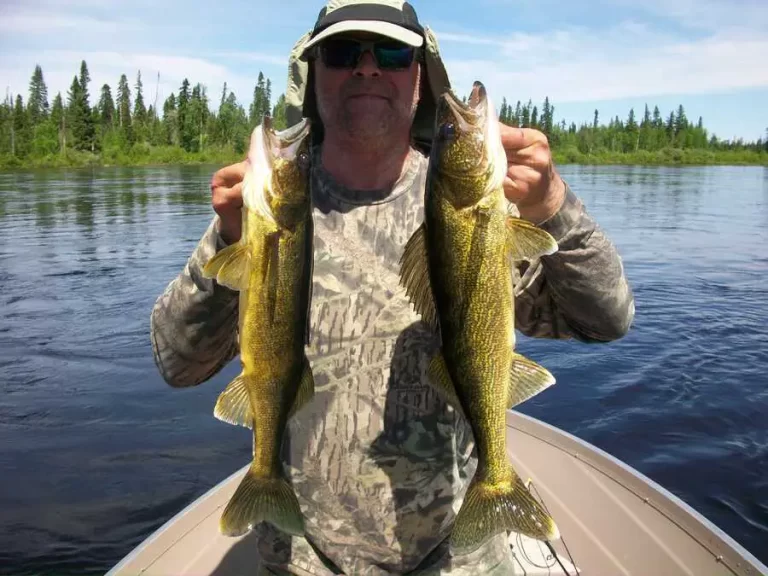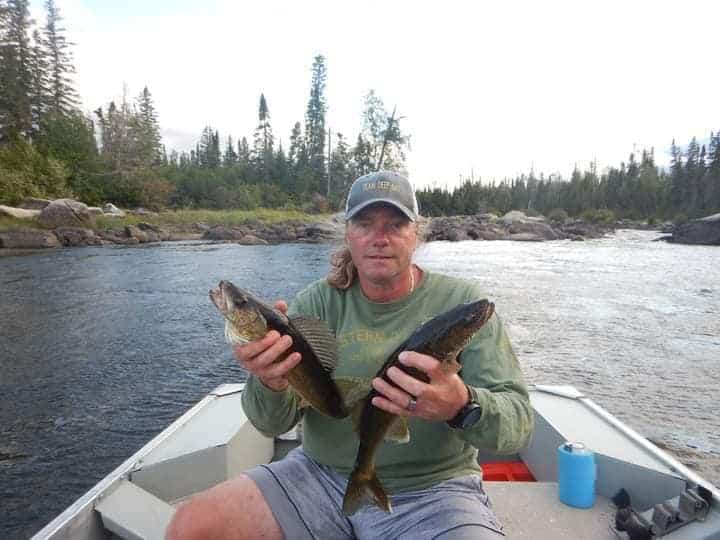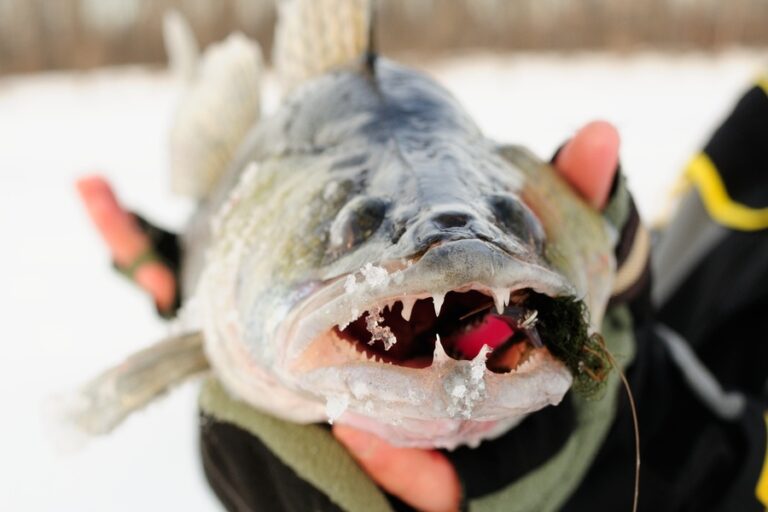Where to Catch Daytime Walleye in Rivers: Complete Guide
Locating walleye during the daytime in moving water can prove challenging. Knowing where to fish in rivers and creeks will make all the difference.
To find walleye during daylight hours in rivers, focus on deeper regions or shaded spots close to natural features like submerged boulders, river curves, and downed logs. Seams and eddies offering calmer water near faster currents hold a lot of daytime walleye.
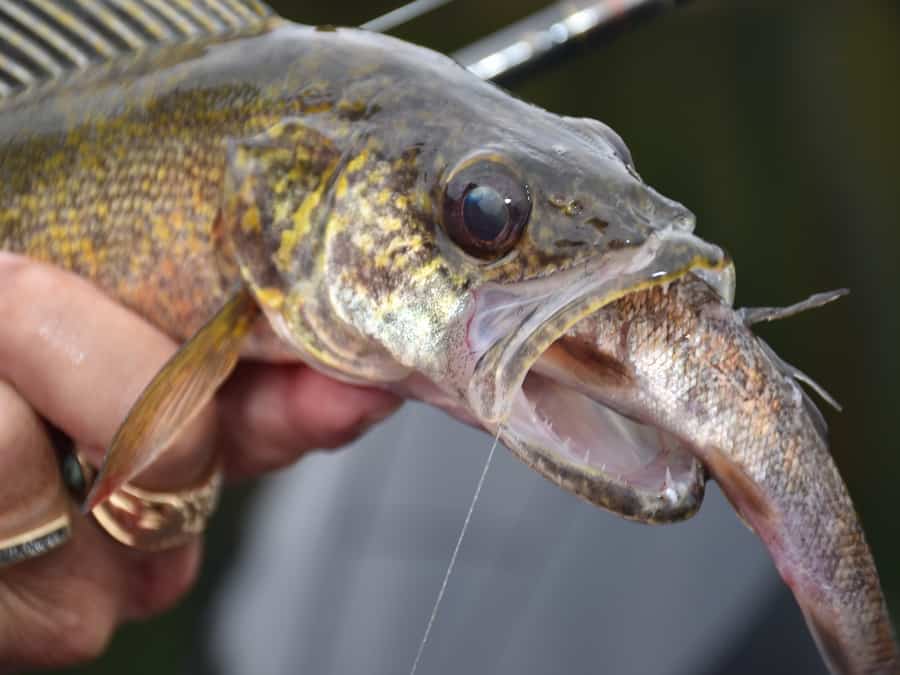
Table of Contents
Where to Catch Daytime Walleye in Rivers
Morning
Early mornings is one the best times of the day to catch walleye. The reduced light makes visibility conditions ideal for hungry walleye. The cooler temps also make walleye more active chasing baitfish.
Look for shallower edges near deeper channels from 5-15 feet of depth. Look for moderate current out of the heavy flow. Underwater features like boulders, submerged logs, and underwater vegetation are great for attracting fish.
Recommended Baits:
- Colors: During the morning, go for natural or muted colors like browns, greens, or silvers to mimic the typical prey during these hours.
- Lures and Baits:
- Jigs: Use 1/8 to 1/4 oz jigs. Brands like Northland Fire-Ball Jigs are reliable choices.
- Crankbaits: Rapala Shad Rap, size 5 to 7, works well during this period.
- Where They Work Best: Jigs work efficiently near underwater structures like rocks or submerged vegetation where walleyes hunt. Crankbaits are suitable for slightly deeper waters and along the edges of deeper channels.
Midday
Fishing will slow way down typically as the day drags on. The overhead sun pushes walleye down into deeper water. Look for depths 20-45 feet deep, especially areas with marginal current so the walleye can rest. Eddies behind large boulders are fantastic spots.
Seams where fast and slow currents meet are great spots, too. While midday is typically slower for walleye fishing, fishing can turn up if a storm approaches. 2 hours until the storm begins can be the best time to catch walleye.
Recommended Baits:
- Colors: Brighter, flashy colors like gold, bright orange, or neon green can attract walleye in the deeper, darker waters.
- Lures and Baits:
- Deep-diving Crankbaits: Berkley Flicker Shad, sizes 7 to 9, can reach the deeper spots where walleye rest.
- Soft Plastics: 3-4 inch paddle tails or bright-colored grubs can be effective.
- Where They Work Best: Deep-diving crankbaits are excellent for the deeper zones walleyes retreat to. Soft plastics work in eddies and seams, where walleyes may be resting.
Afternoon
The early afternoon can still offer pretty slow fishing, but the bite can pick up. I caught some of my biggest walleye around 3 p.m. after the early afternoon. The bite is slower, but big fish will bite.
As the overhead suns weaken, walleye will leave their deep-water holes and move into shallower waters. Look for seams of fast/slower current down about 10-20 feet deep. They will be very close to the riverbed near sandbars or gravel patches. These are prime baitfish locations.
Recommended Baits:
- Colors: As light wanes, transition to more versatile colors like blues, purples, or silvers.
- Lures and Baits:
- Spinner Rigs: Use rigs like the Northland Walleye Crawler Harness. They create vibration and flash to attract the fish.
- Live Bait Rigs: Leeches or nightcrawlers paired with a slip sinker rig can be very effective.
- Where They Work Best: Spinner rigs are great near transition zones, such as where sandbars meet deeper waters. Live bait rigs are versatile but particularly effective near the bottom, close to structures.
Late Afternoon
Late afternoons will be one of the best times of the day to catch walleye in moving water. Walleye will continue moving shallower as the light weakens. They will brave stronger currents now and head into 5-15 feet of water to chase down more active baitfish.
Transitional zones where stronger and weaker currents meet can be dynamite spots. River bends and outlets are also outstanding locations. The water on the outside of the bends will be faster than the inside of the bend.
Walleye will position themselves in these slower water section facing into the fast water. Position your boat in the calmest water and retrieve your baits diagonally across the current seams.
Recommended Baits:
- Colors: As the light diminishes, go for a mix of natural and slightly brighter colors. Consider silvers, light blues, or golds.
- Lures and Baits:
- Minnow Baits: Brands like Rapala Original Floating Minnow, size 5 to 7, can be a good choice.
- Trolling Crankbaits: Deep diving lures like the Bandit Walleye Deep can cover a lot of water and access various depths.
- Where They Work Best: Minnow baits are effective in shallower waters, especially near river bends or outlets. Trolling crankbaits can cover a wide stretch of the river, making them suitable for searching for active walleye in multiple zones.
Click here to learn where to catch walleye. Click here to learn where to catch early morning walleye.
Seasonal Guide: River Walleye Spots
Spring
As water lives in streams and rivers rise after snowmelt and early spring rains, walleye will seek out quieter eddies and seams to find softer currents and clearer water. They feed heavily, preparing for the mid-to-late spring spawning season where they look for sand and gravel zones.
During spring, look for quieter water near heavy currents 5-20 feet deep, especially near riverbanks, boulders, rocks, and submerged trees. The fishing will be hottest before the spawn as walleye must recover from winter and prepare fat stores for the spawn.
Summer
Once the spawn ends and waters heat up in early summer, look for schools of walleye to move into deeper, cooler water. 20-40 feet areas and pools with medium current can be the winning ticket.
I like to look for deeper holes with submerged structure during summer during the daytime. Eddies and seams near strong currents in deeper water can be great too. Fish for walleye in the summer around sunrise and sunset for the best action.
Fall
Fall is my favorite season to catch a lot of walleyes. I love fishing moving baits like jerkbaits and spinners for river fish during the day. We once caught 50+ walleye in a single morning in late September. Watch for walleye to move up into shallower waters from where they were in summer.
Key river locations during this season include areas near underwater drop-offs, rocky outcrops, and river mouths in about 15-30 feet of water. Seams and current breaks are fantastic areas to find hungry walleye. During fall, walleye will be super aggressive chasing baitfish and it’s a great time to catch them.
Winter
Dams can be one of the best wintertime river spots for consistent walleye fishing. I love fishing near dams in winter because they will feature the deepest, slowest water on the river and the dam intself will be warmer than the surrounding water down deep attracting baitfish. Just be sure to keep safety in mind when fishing near dams.
The fishing slows way down once fall gives way to winter. Walleye will return to deeper pools and eddies in the river system. They typically draw out of creeks and into the main river or nearby lake. Look for deep pools of 20-50 feet with light current with structure such as deep ledges, holes, or near dams.
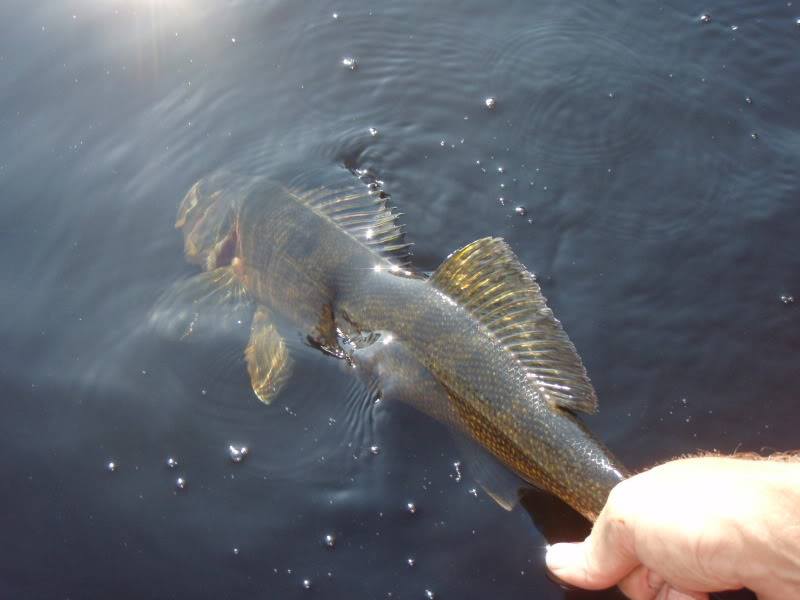
Best Daytime Walleye River Features
Drop-offs & Ledges
- Why They Like It: Drop-offs offer walleye a safe spot to hide from predators and a place to ambush prey.
- Best Depths: 20 to 40 feet during the brightest parts of the day.
- Best Time: Midday when the sun is at its peak.
- Best Presentation: Vertical jigging works wonders here. It mimics the movement of prey coming in and out of their hiding spots.
Underwater Structure (Rocks, Logs, & Boulders)
- Why They Like It: These structures provide shade and protection. Walleye can also use them to trap and hunt smaller fish.
- Best Depths: 10 to 30 feet, depending on the structure’s height.
- Best Time: Afternoon when walleye start to become more active.
- Best Presentation: Use crankbaits or swimbaits that mimic the movement of small fish around these structures.
River Bends
- Why They Like It: The bend in the river slows down the current, creating a calmer zone for the walleye to rest and feed.
- Best Depths: Varies, but 5 to 20 feet is common.
- Best Time: Late afternoon when walleye start moving to shallower zones.
- Best Presentation: Live bait rigs drifted along the bend can be very effective.
Gravel & Sandy Bottoms
- Why They Like It: These bottoms are hunting grounds. Walleye can spot and chase down small fish easily here.
- Best Depths: 5 to 15 feet during the early morning.
- Best Time: Morning, just after sunrise.
- Best Presentation: Soft plastic lures or minnows presented with a slow retrieve work great.
Seams
- Why They Like It: Seams are where fast and slow currents meet. Walleye can rest in the slower water and jump into the faster current to catch food.
- Best Depths: 10 to 20 feet.
- Best Time: Afternoon.
- Best Presentation: Spinner rigs or live bait, presented along the seam’s edge.
River Tips: Locating Daytime Walleyes
- Early Morning Activity: Walleye are generally more active during cooler dawn hours. Target these times for higher chances of locating them. I love fishing early mornings for walleye most seasons of the year.
- Current Breaks: Walleye are often found where fast-moving water meets calmer waters. These areas offer both feeding opportunities and shelter from strong currents.
- Deep Pools: As the sun rises and heats the water, walleye tend to move to deeper spots in the river to stay cool and avoid predators.
- Bridges and Overhanging Structures: These structures provide shade, cooler waters, and concealment. Look for walleye hiding in the shadows of bridges and overhangs.
- Rocks and Boulders: Areas with significant underwater rock formations can be ideal. Walleye use these for protection and as ambush points for prey. I love finding rock, especially during winter down deep. This is where I find the most consistent cold-water walleye.
- Logs and Submerged Trees: These natural structures are perfect hideouts for walleye. They offer shelter and attract smaller fish, providing a feeding ground for walleye.
- Sandbars Near Deeper Waters: Sandbars can serve as resting areas for walleye, especially if they’re adjacent to deeper channels or pools.
- Post-Rain Muddy Areas: Muddy zones can draw in baitfish after rain, attracting walleye looking for a meal. Look for transitions of clear water and muddy water. Walleye will rest in the clear water.
- Lure Choice for Water Clarity: Opt for brighter or more reflective lures in murkier waters. In clearer waters, natural colors mimicking local prey are more effective.
- Water Flow Near Dams: The water flow in these areas brings in smaller fish and nutrients, attracting walleye. However, always ensure fishing near dams is allowed and safe. Dams are one of my favorite locations for daytime walleye fishing.
Frequently Asked Questions (FAQs)
Why are daytime walleye harder to locate in rivers compared to nighttime?
During the day, walleye will be down deeper making it harder to get baits deep enough in rivers to get bites. At night, walleye move up higher in the water column and usually feel safer to feed.
How does water clarity affect daytime walleye locations in rivers?
Clear water forces walleye down deeper in rivers during the daytime. If the water is muddier or stained, walleye will be closer to the surface chasing schooling baitfish.
What types of river structures or features are most attractive to daytime walleye?
During the day, walleye will congregate around river features like deep holes, underwater rocks, and river bends. They will also focus on seams where slow and faster currents meet, and on eddies where calm water can be found behind boulders.
How do varying current speeds impact where I should fish for walleye during the day?
Walleye don’t want to waste energy fighting strong currents all day. They prefer spots with slower water or places protected from the fast current. Look for them in calm water near fast-moving water, like the sides of a rapid.
Are there specific lures or bait that are more effective for daytime walleye fishing in rivers?
Lures that look like small fish, especially those that shine or shimmer, can be good for daytime fishing. I love using “ghost” or natural colored baits which look the most natural during the daytime, especially in clear water. Live bait like worms or leeches can work well too.
How do you shore fish for walleye in a river?
The best location to catch river walleye during the day from shores is around a strong river bend. Walleye will sit along the river seam in slower water with their faces looking at the faster water moving around outside the bend.
You should be able to cast your lures from the inside bend of the river and retrieve with the current right across the face of many walleye. If you find rock or submerged timber here, even better.
What depth do walleyes like in a river?
During the day, walleye often stay in water between 15 to 40 feet deep. This depth range offers them good cover, color temperatures, and access to baitfish attractive structure like rocks, ledges, and sunken timber.
Where do you find daytime walleye in small rivers?
Find the deepest holes when fishing for daytime walleye in creeks and small rivers. Walleye will push down as deep as possible and hold tight to any deep structure like ledges and large rocks. Another great spot is where a small river/creek meets a larger river.
Conclusion
Walleyes should be deep near natural structure during the daytime in rivers and streams. Early mornings will see the best fishing of the day in shallower water around 5-15 feet of depth. Midday, walleye will be at their deepest around 20-45 feet in pools, holes, and ledges.
They will then move shallower as the day progresses with fishing again peaking in the late afternoon near sunset. Seams and eddies will offer the best walleye fishing by the end of the day

